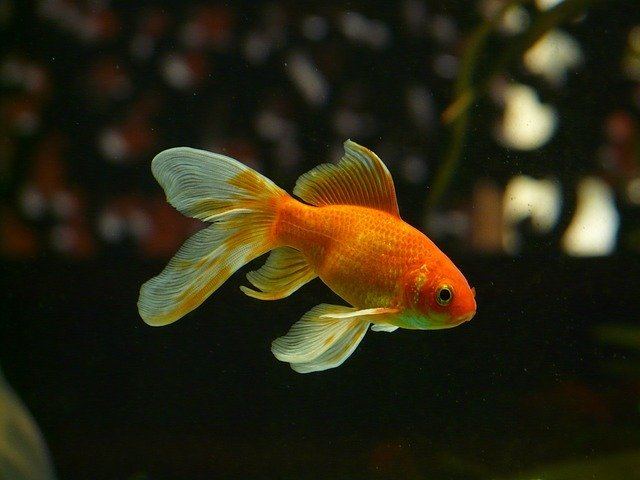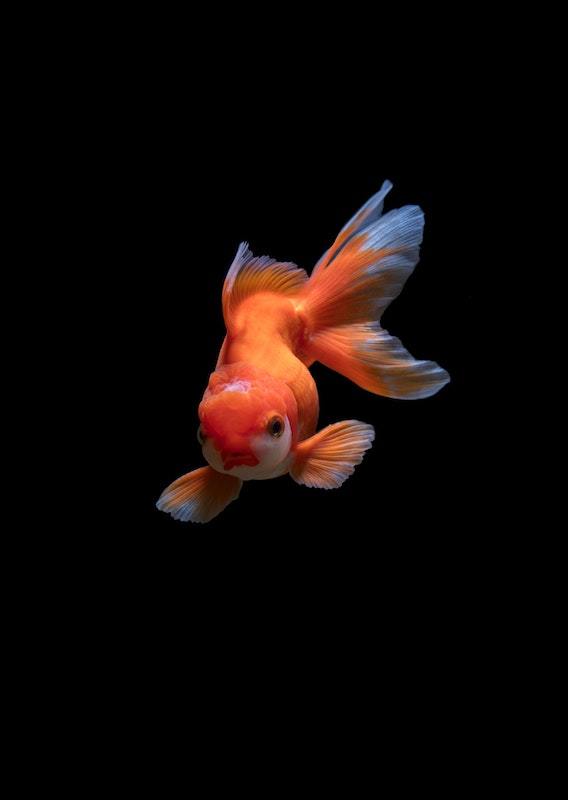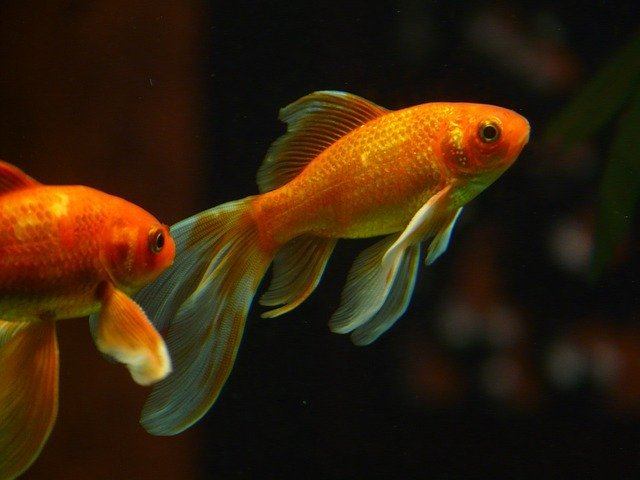Goldfish come in many different colors, from vibrant yellows and golds to darker browns and reds. As it turns out, however, these vivid colors are not their natural ones; instead, they’re the result of selective breeding.
Over time, these colors may start to fade or even darken, which can be concerning for many aquarists. Is your fish sick? Are they dying? Why do goldfish turn white anyway?
Let’s take a look at why your goldfish is changing color below. By the end, you’ll be able to better assess your fish’s health, and either enjoy their new look or take steps to see them recover.
Contents
Why Is My Goldfish Turning White?
The most typical color change in goldfish tends to be from gold to white, though other color changes are possible as well.
The majority of these color changes take place within the first two years of a goldfish’s life. Most goldfish are born either brown or black in color to help them blend in with their environment and survive being eaten by predators. It is only when they mature that they gradually become their characteristic orange or golden-yellow color, though their specific color change will depend on a wide variety of factors.
Scale Types
Most domestic goldfish have one of three main scale types. Each of these types contain a different density of pigment cells within them that determines if and how your goldfish’s scales will change in color over its lifetime.
Metallic Scales
Metallic fish scales are typically made up of guanine, a crystalline pigment that can mirror light, hence their “metallic” look. They also contain large amounts of xanthophores and erythrophores, which can give your goldfish either a bright red or orange/yellow coloration respectively.
Metallic-scaled goldfish typically have stable coloring throughout much of their life, so you’re unlikely to see their colors change that much.
Nacreous Scales
Nacreous scales will have some guanine, but not as much as metallic scales. Depending on the guanine density in a particular fish’s scales, they may either look a bit metallic or have a mother-of-pearl sheen to their coloration instead.
Some nacreous goldfish will have translucent scales, while other nacreous-scaled goldfish will be black, dark red, yellow, or a mixture of these colors. Their pigment cells lie underneath their scales, so their coloration may be duller than their metallic-scaled counterparts.
These scales are more likely to change coloration over time.
Matt Scales
Matt scales typically do not contain much (if any) guanine or bright pigment cells. As such, these goldfish tend to be white, pink, light gray, or cream in color, or they may simply possess translucent scales.
Because these fish do not have any pigment cells, they will not change their colors at all throughout their life. They cannot change what they do not have, after all.
Environmental Causes
Lack of Light
A lack of sufficient lighting is one of the more common environmental reasons for goldfish turning white or even black, depending on their dominant genes.
The pigment cells found in goldfish scales react to light, and when goldfish live in environments that do not get much sunlight, their scales may be darker or duller in color when compared to those that live in more well-lit waters. Over time, they may even lose their color entirely and turn white.
Poor Water Quality
Factors like water temperature and water quality can also play a role in their coloration.
If you notice your goldfish becoming white very suddenly, this could be a sign that their tank’s water quality is rather poor. This could be due to ammonia poisoning, a sudden influx of nitrates or oxygen, or an increase or decrease in water temperature.
You should always use a special chemical kit to test the water quality in your aquarium every so often. An imbalance in chemicals can mess with your goldfish’s ability to regulate their pigmentation, resulting in especially pale or dark-colored, fish rather than the vibrant ones you raised.
Ammonia is first created from your fish’s waste, and is thus the first toxin to form in the nitrogen cycle. This toxin is only ever present when your tank lacks any beneficial bacteria or there is a sudden spike in the cycle. Goldfish cannot tolerate high amounts of this toxin in their environment, so getting rid of it should be your first priority.
If you find that the ammonia levels are extremely low or at zero, test the KH levels next. Most goldfish will be comfortable at around 100 to 140 ppm, though they may tolerate slightly higher readings if need be.
If your kit reads over 160 ppm, you will need to mix a white vinegar solution into the tank to reduce these levels. Never add the vinegar directly into the tank without diluting it, as this could cause your fish to go into shock and die.
Mix 1/2 teaspoons of vinegar for every 10 gallons of freshwater you plan to change out. After one hour has passed and your fish seem to have adapted to the change, test your water again.
If the KH levels are still too high, pull out another gallon of water, add more vinegar solution, and repeat until the water reaches acceptable parameters again. Always administer this solution gradually, so as not to shock your goldfish.
You should ideally test your aquarium’s water at least once a week, at the same time each week, to ensure your water is within parameters. If you are trying to improve the quality of your tank water, then you should increase that testing to once a day as you work to improve it.
Health Reasons
Goldfish may get sick or die for any number of reasons, and that illness can easily spread to the rest of the aquarium. Therefore, being able to detect the symptoms of illness in goldfish early is crucial to the safety of the entire tank.
You should always look over your fish for any signs of disease or death right before feeding. If you notice even a single fish displaying symptoms, try to see if any other fish in the tank are suffering from similar signs. This will help you figure out what the underlying cause of it may be.
Breathing Disorders
If you notice your fish gasping for air, breathing rapidly, staying near the surface of the tank, or even lying at the bottom, they may be having trouble breathing or getting enough oxygen in their system.
Parasites
Nearly every fish parasite is easy to spot, so be sure to examine your fish’s body every day as you go to feed them. Some parasites (like worms, leeches, or flukes, for example) will be visible on their bodies, while others may be causing them trouble internally.
If the parasites are on your fish’s body, you will need to manually remove them with a tweezer. You may also need to take them to your veterinarian for any follow-up treatments to prevent bacterial or fungal growth.
Goldfish are, more or less, always hungry. So, if you notice that they are not eating as much as before or they’re losing weight for some reason, then they may have internal parasites. These parasites may also cause them to act listless or swim around erratically.
If you notice any redness, irritation, bloating, and/or thread-like worms coming from the fish’s tail area, then they may be suffering from a nematode infestation. These parasites live in your fish’s intestines and will need to be treated by your veterinarian.
Swim Bladder Disease
If your fish is swimming erratically, upside-down, or constantly crashing against surfaces, they could be suffering from swim bladder disease.
Fungal Disease
If your goldfish is bloated, has folded or torn fins, shows discolored spots, lumps, and protruding eyes, or has pale gills, they may have a fungal disease.
Fin Rot
Fin rot, otherwise known as tail rot, is one of the most common fungal diseases among fish. This disease begins to eat away at the edges of their fin and will gradually destroy more and more of it until it reaches the base of the fin. As a result, your fish’s fins and tail may look ragged or frayed, or have milky white areas on them.
Fin rot is generally caused by harmful bacteria that eats away at the membranes of the fish’s fin, leaving them vulnerable to secondary fungal infections. This bacteria thrives in neglected tanks, so you must always keep a strict cleaning or water changing routine to prevent this from happening.

Overfeeding fish can result in many problems, including poor water quality and increased stress.
The same can be said of overcrowding a tank, though you will have a higher risk of disease spreading, along with more aggressive fish starting to snap at or injure the fins of other fish in the same tank.
Age
Your fish may simply change their colors several times throughout the course of their life without any provocation. If you know what color their parents were, then you may be able to predict what color your goldfish will become.
For example, if your fish’s parents had white scales, your goldfish may become lighter to reflect that. If you find yourself with a white goldfish for this reason, then there is no need to worry! So long as they are still eating and swimming around your tank properly, then they are a healthy and happy fish. Enjoy their new look!
How to Avoid Goldfish Turning White
Exposure to Light
If you do not want your fish to turn white, simply move their aquarium to a part of your home that gets a decent amount of sunlight. Alternatively, you can install artificial lights somewhere nearby. Goldfish need to be exposed to about 12 hours of either sunlight or artificial lighting a day to ensure they mature into the nice golden coloration you want.
Without any exposure to light, goldfish will stop using resources on color production and maintenance, and they may become white or black as a result. This is because darkness promotes more melanin (or black pigment) production and less chromatophore (or color pigments such as yellow and red).
Quarantine Your Sick Fish
If you notice your goldfish is sick or dying, then you will need to separate them from the rest of their tankmates (assuming they have not been infected already), so they do not spread their diseases.
Fill their quarantined tank with water from their old tank to help them relax.
However, if there is something in that water that is causing them to be sick in the first place, this could only make their symptoms worse.
Either way, you will need to take them to see your veterinarian as soon as possible.
Change Their Diet
It may seem odd that a fish’s diet can affect their coloration, but this does appear to be the case with some types of goldfish! To prevent any coloration changes, simply feed them veggie-type foods like peas or blanched zucchini, or even fresh plants such as duckweed.
If your goldfish is black or simply has a dull or dark coloration, you can actually brighten their color by providing them with a carotenoid-rich diet or by giving them a high-quality, color-enhancing food.
Accept That It Is In Their Genetics
Usually, color changes are ruled by the fish’s genetics and there is little that you can do to prevent it. It is simply a part of their development and a healthy trait in their genetics.
If this upsets you, you should perhaps think about getting a different species of fish, whose coloration is not prone to fading or changing over time.
Conclusion
If you wake up one day to a white goldfish, this can be understandably worrying. However, this color change is not always something to be feared!
So long as you keep your fish’s aquarium as healthy as you can, most of the time, you will not need to worry about this color change being a sign of poor health or water quality. It may be their fancy new look, and nothing more!
Do you have any goldfish?





